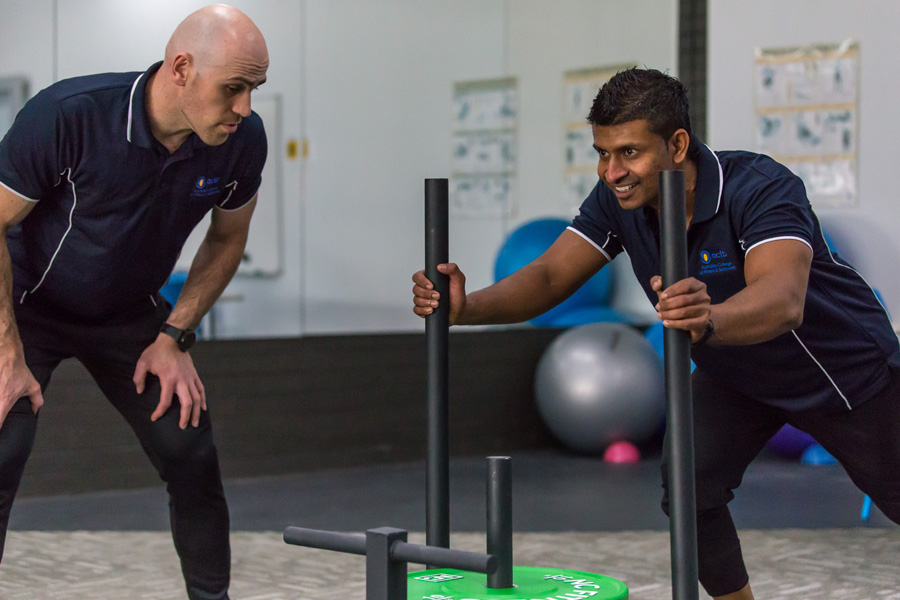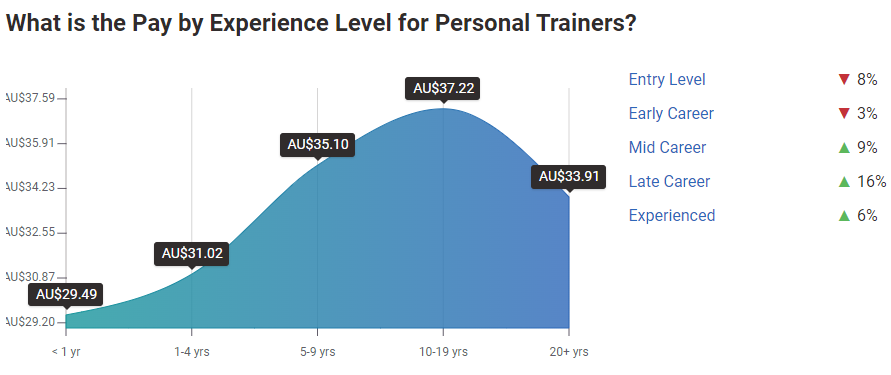How Much Does a Personal Trainer Earn?
Personal Training Industry Growth
Over the past few years, the Personal Trainer (PT) industry has rapidly grown in Australia. Now in 2024, fuelled by rising obesity rates and a general growing awareness and interest in fitness, health and well-being, Australians are increasingly turning to personal trainers to get in better physical shape and start living a healthier lifestyle. This in-demand service has resulted in the personal trainer industry becoming one of the fastest-growing careers in the country, which makes personal training professionals highly sought after across multiple sectors. What’s even more appealing is that this demand is expected to keep growing at an unprecedented rate. According to Statista, the Health and Fitness segment in Australia is projected to reach $196m in 2024 and is set to continue this growth, reaching a projected $262m in 2027. This growth is likely because of new fitness trends emerging, including Wearable Technology, Online Coaching, and Exercise is Medicine. EIM is a global health initiative that aims to encourage health practitioners to include physical activity assessments and promotion as part of standard care. ( Source: www.statista.com)

Fitness Participation Rates & Rising Health Consciousness
Health consciousness continues to grow amongst Australians across various age groups. Data gathered by the Australian Bureau of Statistics (ABS) indicates that fitness/gym activities were the second most popular activities engaged in by Australians. Over the past decade, these participation rates in fitness/gym activities have increased from 12.6% to 17.1% and 17.4% in 2005-06, 2011-12 and 2013-14, respectively (source: www.fitness.org.au ).
So, why are we seeing increasing fitness participation rates and why are they projected to continue growing? Well, a contributing factor is that Australia has one of the highest obesity rates in the world – with over 29% of the adult population falling under that category (source: data.worldobesity.org) Coupled with an ageing population, Australians are increasingly recognising the benefits of regular exercise and its positive effects on general health and well-being.
A Burden of Disease Study published in 2021 by the Australian Institute Of Health and Welfare has found that 38% of the disease burden could have been avoided or reduced by addressing modifiable risk factors. These risk factors include tobacco use, being overweight, and obesity. THE AIHW also found that a 26% reduction in disease burden due to physical inactivity could be achieved by participating in 30 minutes of activity at least 5 days a week. (source: aihw.gov.au). Given this relationship between physical activity and health, including obesity and the risk of chronic disease, it’s no wonder that health consciousness is on the rise in Australia, as is the demand for fitness professionals. This rise in health consciousness is further compounded by the after-effects of the pandemic, with more focus moving towards improving the health and well-being of Australians to prevent severe SARS-COV-19.
This renewed focus on health creates a greater demand for fitness professionals to help guide Australians to improved health and a reduced risk of serious illnesses including heart disease, diabetes, certain cancers, and severe Covid-19.
Personal Trainer’s Role
Whether avid fitness participants or newcomers to the world of exercise, many people are turning to personal trainers to receive individually-tailored, one-on-one fitness programs. These highly skilled fitness professionals take factors such as age, sex, individual needs, previous or existing injuries, medical conditions, and current health and fitness into account when developing and implementing a fitness regime. For the consumer, this specialised program is appealing because it is results-orientated, helping them achieve personal fitness goals and meet health needs. Furthermore, it also allows the PT to monitor a client’s progress and continually adjust their exercise program to meet changing fitness level needs. Best of all, a PT can guide, educate, motivate and inspire clients to reach their set goals.
Employment Prospects For Personal Trainers
With Australia’s continuing rise in health consciousness in 2024, personal trainers are in high demand. Clients can range from individuals looking to make lifestyle changes and improve their health to organisations wanting to promote team building, the potential for personal trainers to find work extends across multiple sectors.
Generally speaking, there is no shortage of work in the personal training field. According to the ABS Labour Force Survey, the number of Personal Trainers declined during the last 5 years. This is likely due to the effects of Covid-19 and the subsequent regulations. However, they have forecasted that these numbers will grow tremendously over the next five years, with the number of Personal Trainers likely to reach 39,800 by 2026. (Source: labourmarketinsights.gov.au).
Furthermore, full-time fitness industry professionals work around 45 hours per week compared to the all jobs average of 44 hours. For a further snapshot of the fitness instructor industry, see the information below:
Overall, although work hours for personal trainers are based around their client’s needs, they are generally more flexible than most 9 to 5 workplaces. And if that isn’t appealing enough, the expected pay can also be very rewarding.
What Does A Personal Trainer Typically Earn?
The latest data shows that the average hourly rate for a Personal Trainer in Australia is around $32 per hour. This has risen by 4% from 2023 to 2024.

Source: PayScale Australia
However, a Personal Trainer can earn as much as $124K per year, or $61 per hour depending on their experience and qualifications. By upskilling and specialising in areas such as strength and conditioning, health and nutrition, weight loss, and rehabilitation, a PT can markedly increase their base salary. In fact, data collected by PayScale shows specialising in Sports Nutrition can increase a PT’s salary by 25%.
You can also further improve your earnings by keeping up-to-date with professional development and abreast of current best practices. Another factor that contributes to your earnings as a Personal Trainer, is whether you work for a gym or if you are self-employed. If you are not contracted to a specific company, you are able to earn a higher income since you will be able to set your own rates based on your skills, experience, and specialisations.


Source: PayScale Australia
What all this means is that beginning a career as a personal trainer will see you entering a growing field that has many current and future job opportunities and the potential to earn a great salary. So, if you are thinking of embarking on a new career in the fitness industry, not only can this be an exciting opportunity, but it can also be personally and financially rewarding.
Field of Work For Personal Trainers
What makes it so exciting to become a personal trainer in this climate, are the limitless opportunities a qualification in personal training can offer.
While the traditional personal trainer works as part of a gym, the possibilities reach far greater than that. You have the skills to run outside boot camps for larger groups, enjoying the freedom to run them as frequently as suits you and your client’s schedule. Some personal trainers explore at-home work, where the trainer will go to the client’s home and work within the confines of a client’s house or apartment building gym.
As a result of the COVID 19 Pandemic, there are also a large number of trainers pivoting to online pre-recorded and live classes. Some personal trainers record class-style workout sessions and upload them for clients to come to at their own convenience – this is perfect for your clients who have particularly erratic schedules or don’t like to work out in the company of others.
For those really looking for a change of scenery there are regular personal trainer positions available on resorts, spas, and even cruise ships. As well as that, a great number of personal trainers are now looking at finding employment at community centres, where they run classes and can spread their talents between gym work, sports, aquatics, and group fitness sessions.
The Old Meets The New- The Hybrid Model
Due to the pandemic and the lockdown regulations that followed, many Personal Trainers have had to adjust to online training as a training model. Although this model is not new in the fitness industry, social distancing and other Covid regulations have caused an increase in the uptake of online training. By adopting this model, PTs have been able to continue serving their clients during lockdowns. With the new milder variant and increased rates of vaccinations, Covid-19 restrictions have lifted and we’re now seeing personal training return to some form of normalcy, while some clients still prefer the online training.
According to the Australian Industry and Skills Committee, online training is predicted to be one of the top trends for 2022. (Source: Nationalindustryinsights.aisc.net.au.) This means PTs may have to adjust to a hybrid model, which includes in-person training and online training.
This is good news for PTs who are looking for ways to maximise their revenue and increase their client base. A hybrid model allows PTs to take on more clients since most of the training will occur online through apps and trackers, with clients attending fewer in-person sessions, while still getting results. The hybrid model also allows for greater flexibility and the opportunity to help more people reach their health and fitness goals. PTs can also choose to only train clients online, which allows them to reach a wider audience since geographical location does not constrain them.
Other Advantages To Being A Personal Trainer
A career in personal training offers more than a comfortable wage when it comes to staying healthy, enjoying work/life balance, and choosing your hours. It is essential to consider these things as job satisfaction often encompasses more than just the pay packet.
Outside of monetary reward, a career in personal training allows you to:
- Stay healthy
Keeping in shape is often tricky for those who work full-time and are out of energy at the end of a workday or dread an early rise to get to the gym. A career in personal training puts you right in the spot with all of the proper equipment meaning a workout in between clients is easy, not to mention the active work you will be doing while training others.
- Help others
One of the most rewarding aspects of being a personal trainer is the satisfaction you will get from improving the lives of your clients, helping them to achieve their goals and become healthier and more confident.
- Work within your passion
If you love what you do, you’ll never work a day in your life. If health and fitness are strong passions of yours, a job as a personal trainer will be very enjoyable, plus you’ll be able to build the knowledge and skills you already have to teach other people.
- Find new career opportunities
The flexibility of working in a gym, health club, sports club, or even a cruise ship provides some interesting and exciting career opportunities. You can also set up your own business and choose your hours to enjoy a flexible schedule. Keep in mind you will need to consider when clients are able to train (early in the morning or late at night due to work), but for the most part, you have control over your time.
How Much Do Gyms Pay Personal Trainers?
Remuneration for fitness coaches varies across fitness centres. One common approach involves the assignment of a fixed commission, typically ranging from 30% to 60% of the session fee. For instance, if a fitness centre charges $100 per session and offers a commission rate of 50%, a coach would earn $50 per session, with the remainder being retained by the centre.
Some fitness centres adopt a performance-based approach, offering a graduated commission system. In such a structure, you could earn a 30% commission for 10 training hours per week, escalating to a 40% commission for 20 or more hours. The more clients you engage, the higher your income potential, encouraging fitness coaches to adopt a proactive, sales-oriented role. Additionally, some gyms just opt to just pay personal trainers an hourly wage.
How Many Hours Do Personal Trainers Work A Week?
On average workweek spans somewhere between 25 to 40 hours. These hours are typically distributed among gym sessions, classes, meeting clients, and also marketing/brand efforts. However, these can vary greatly depending on the trainer and the nature of the services they provided.
Some personal trainers operate part-time while others commit to a full-time schedule. The rise of online services in the fitness industry allows for greater flexibility in how personal trainers structure their workdays.
Personal trainers tend to split their day into two sessions, morning and evening. This suits their clientele well, especially those who are working professionals looking to squeeze in a workout before or after their standard work hours.
It’s not uncommon for trainers to be up at the crack of dawn, around 5 or 6 am, prepping for their morning sessions. The afternoon usually presents a break period, after which they gear up for the evening sessions. This flexibility and dedication make personal trainers an essential part of the fitness industry. As professionals, they are adept at adapting to the needs of their clients, ensuring that they can provide their services at times most convenient.
ACFB – Helping You Become A Personal Trainer
If you are interested in health and fitness and have considered a career as a personal trainer, you’ve come to the right place. The Australian College of Fitness & Bodywork (ACFB) is dedicated to providing award-winning and nationally-accredited education and training in the fitness field. With its long and accredited history, ACFB has been helping students achieve their dreams of becoming a personal trainer since 1989. Honoured as the Department of Education’s 2013 Victorian Small Training Provider of the Year, ACFB delivers a first-rate education. Our highly qualified and dedicated staff have many years of experience in the fitness and education industries, ensuring you learn about current best practice and industry standards from knowledgeable fitness professionals. Begin a new and rewarding career in personal training today. Contact ACFB on 1300 002 232 and our friendly staff can help you find the right Personal Trainer (PT) course to suit your needs.




